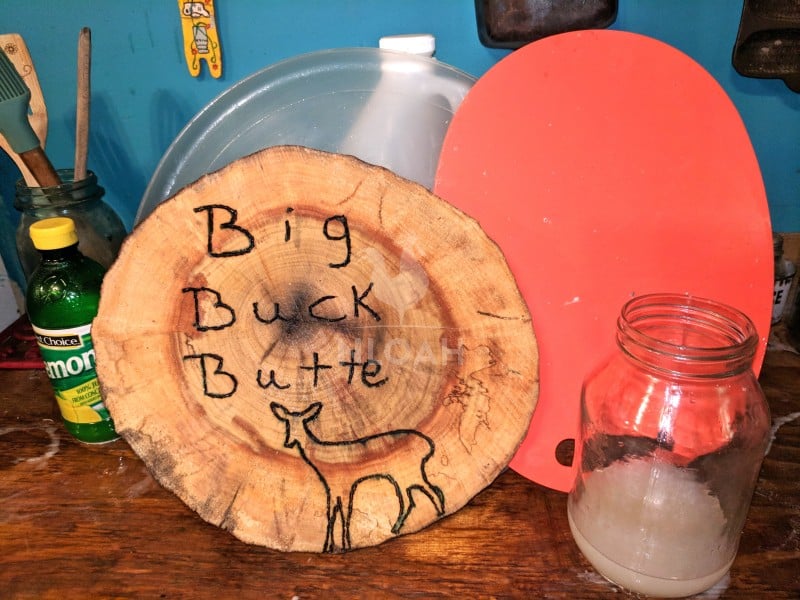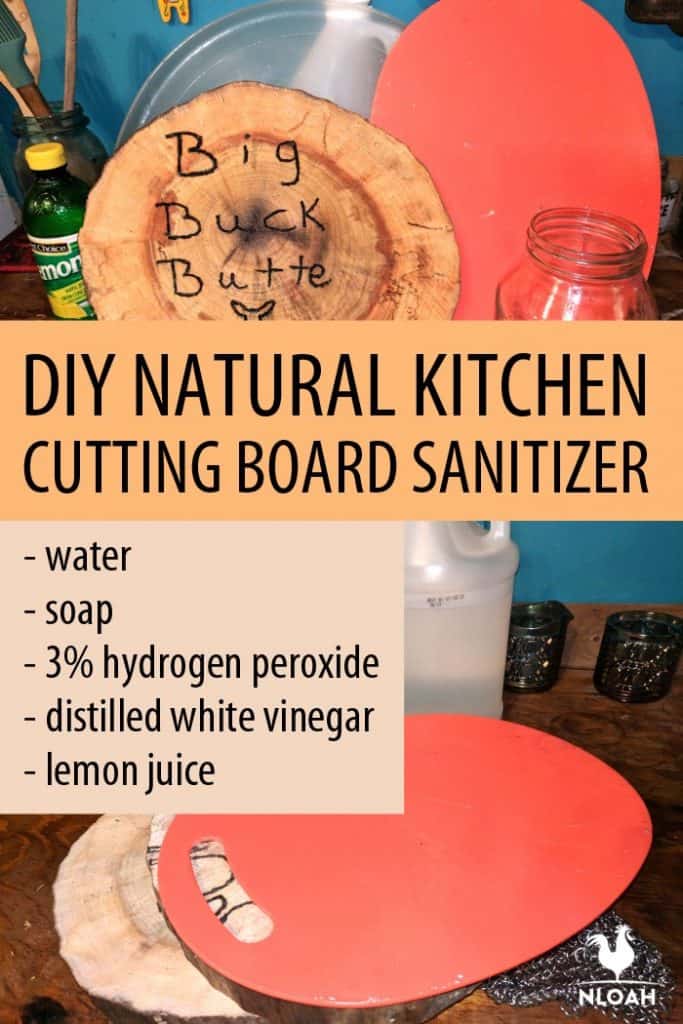Sanitizing your kitchen cutting board is a must to prevent bacteria from forming, and making your family ill. Using chemical laden commercially manufactured cutting board sanitizers could defeat your family’s health goals, and cost a lot more money than making an all-natural disinfectant in mere minutes.

The kitchen cutting board gets as much traffic as the fridge handle on most homesteads, especially during garden canning time of the year. Keeping the cutting board or chopping block clean during near constant use, especially when processing meat, can feel like a tedious chore, but an essential one all the same.
Skip the Commercial Cleaners
Some folks use commercially manufactured disinfectant wipes on their kitchen cutting boards, but, even though they may rid the kitchen tool of bacteria, they can release potentially ailment causing chemicals on the cutting board, as well.
Bleach has been used for decades to clean and disinfect kitchen cutting boards. The distinctive smell of freshly used bleach in a kitchen was a sure sign it has just been cleaned.
Unfortunately, all that cleanliness can come with a high cost to your health. If you want to learn more about the possible toxic effect of using bleach, check out the DIY natural bleach alternative recipe post.
Kitchen Cutting Board Types
Kitchen cutting boards come comprised of multiple different types of materials. Wood, plastic, bamboo, and silicone are the most popular. Wood cutting boards can be the most problematic to thoroughly disinfect because they are so porous.
Bacterial can nestle deep inside the voids created in the wood over time due to all of the chopping and banging with cleavers these durable kitchen tools endure.
The DIY all-natural disinfectant spray works great on silicone and plastic kitchen cutting boards, but both bamboo and wood cutting boards require a more astringent approach to bacteria eradication.
I basically loathe plastic and never use it for anything in the kitchen, bathroom, herbal apothecary, and barn unless it absolutely cannot be avoided.
If you have a plastic cutting board, take a long gander at all of the nicks and slashes into the cutting board that knives have made over time. Where do you think all of those miniscule bits of plastic ended up after being at the service end of a sharp knife? My best guess is in the food that was being chopped.
Years ago now, the possibility of the chemicals contained in plastic leaching into food I serve my family prompted me to throw out an attractive set of plastic cutting boards I was gifted. There is also a significant likelihood that plastic cutting boards could contain phthalates or BPA. Both chemicals are regarded as hormone interrupters.
Even though wood cutting boards require the most work to stay in quality shape and clean, they are still my favorite type to use, as is the case with many homesteaders who favor a more old-fashioned or traditional approach to preparing and preserving food.
DIY Natural Kitchen Cutting Board Sanitizer Recipe and Steps
The Pre-Wash Phase
Before you disinfect any cutting board, it must be washed thoroughly to remove all tiny bits of food particles and grime from the surface – both the front and the back of your cutting board are reversible.
Washing away the goo that you may not see or even feel on the kitchen cutting board will reduce the amount of possible parasites and viruses the disinfectant is charged with eradicating.
The Cleaning Phase
- Rinse off the cutting board in hot water to loosen or remove food residue.
- Wash the wood or bamboo kitchen cutting board in warm soapy water while your give it a good scouring with a stiff cleaning brush.
- If you have particularly stubborn food stains or debris, rub a few pinches of standard table salt onto the cutting board to remove them.
- Rinse the cutting board, again and place it in a dish strainer to allow it to air dry for approximately 20 minutes.
The Disinfection Phase
The amount of 3% hydrogen peroxide you use to disinfect the wood or bamboo cutting board will depend on both the size of the board and how deeply it needs disinfected. Typically, I use about 1 cup of hydrogen peroxide on a cutting board that measures roughly 12 X 24 inches.
If raw meat was cut on the board, or if it has multiple nicks and voids from knife cuts, double the amount of 3% hydrogen peroxide.
The hydrogen peroxide will fizz when it hits the cutting board, just like it did on a skinned knee when you were a child. You can simply pour it onto the kitchen cutting board or place the board in a pan and soak it.
I like to gently rub the peroxide around lightly with a sponge to make sure the entire surface, as well as indentation and cuts in the board, are thoroughly coated.
If you go the soaking route, always finish the disinfection step by standing the board upright and dousing it with a few squirts from the peroxide bottle to finish it off.
You do not want any bacteria residue to linger on the cutting board, which might be able to occur since it was allowed to rest in the cleaning bath.
Once all of the fizzing sparked by the hydrogen peroxide has stopped, rinse the cutting board under hot water, and allow it to air dry yet again.
Sanitizing and Deodorizing Phase
- Pour approximately 1 ½ cups of distilled white vinegar into a spray bottle.
- Add in about 3 tablespoons of lemon juice or 5 drops of lemon essential oil – optional but highly recommended.
- Put the spray nozzle attachment on the bottle, and screw it firmly into place.
- Shake the spray bottle vigorously for at least 30 seconds.
- Squirt down the wood or bamboo kitchen cutting board with the DIY natural sanitizer from top to bottom while holding it upright.
If the kitchen cutting board still holds an unpleasant odor after completing the steps above, cut a lemon in half and rub it all over the surface of the wood or bamboo. Allow the lemon juice to work its magic for about five minutes before gently wiping it away.
Wood Cutting Board Care Hints and Safety Tips
To keep the wood cutting board in tip top shape to increase its longevity, lightly wipe it down with coconut oil after heavy use, or about once a month. Place the cutting board in a kitchen strainer or prop it up against something to allow it to completely air dry before storing it away.
Because kitchen cutting boards are nearly always made out of hardwoods, their fine grain can allow the capillaries of the wood to drag bacteria in and trap it.
Because of this fairly likely possibility, never skip the important rinse and thorough drying steps noted in each section above. It is during the drying process of each noted step that the potentially trapped and harmful bacteria is fully eliminated.
Should You Ever Want to Make Your Own Cutting Board…
I am in the midst of making cutting boards for Christmas gifts, using hardwood that was harvested from our survival homestead. I am going to wood burn a design or text into each cutting board to personalize them.
These cutting boards are not only beautiful heirloom style gifts, but cost you absolutely nothing to make. But, the indentations made by the wood burning process will create permanent voids in the kitchen cutting board.
If you decide to make your own cutting board or create some as gifts like I am doing, please include a care sheet (preferably this one, of course) with the cutting board so the delighted recipient will know how to keep the board sanitized properly – and attractive for years to come.


Tara lives on a 56 acres farm in the Appalachian Mountains, where she faces homesteading and farming challenges every single day, raising chickens, goats, horses, and tons of vegetables. She’s an expert in all sorts of homesteading skills such as hide tanning, doll making, tree tapping, and many more.

I meant to say lemon zest not lemon juice.
Tara,
I’ve been doing this for decades except I use lemon juice! Glad you shared it. Isn’t it a shame that you have to put directions like attaching the sprayer nozzle back on the bottle these days. So many people lack the common sense to do this step without reading it. LOL
Awesome! Thank you for this. I have a cutting board for meats and a separate one for veggies.